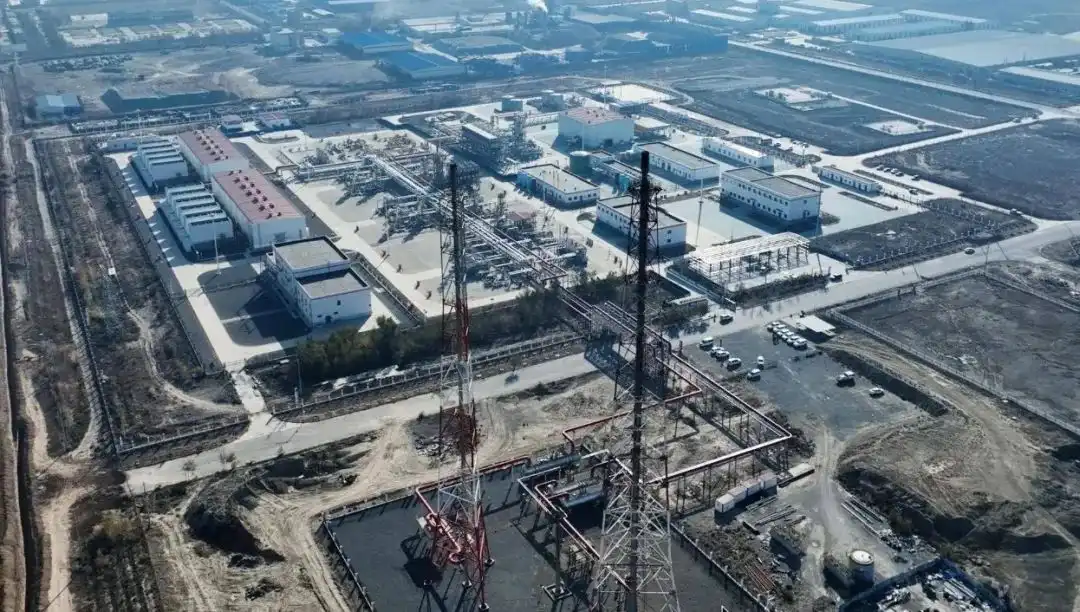The role of the regulator in ensuring the supply of gas storage is constantly highlighted
The gas storage withstood the test of fluctuating weather with a temperature difference of more than 30 degrees Celsius, completed the task of ensuring supply in extremely cold weather, and delivered a remarkable answer sheet.

▲ The picture shows China's largest gas storage-PetroChina Hutubi Gas Storage.
As an important gas storage facility, underground gas storage is an important part of the natural gas supply chain and plays an important role in peak regulation and safe supply of natural gas in China. According to a reporter from China Energy News, during the heating season last winter and this spring, the country's gas storage capacity increased by 3.8 billion cubic meters, and the increase exceeded 3 billion cubic meters for the first time in nearly 20 years, constantly adding "confidence" to the supply of natural gas.
“中国石油各储气库在刚刚结束的冬季保供期内调峰采气量144.7亿立方米,工作气量近200亿立方米,最大日采气能力达2.2亿立方米,相当于中国制造气一半的日产量,也可以说是一个西南油气田加塔里木油田的日产气量总和。” Wanyan Qiqi, deputy director of the Underground Reservoir Research Center of China Petroleum Exploration and Development Research Institute 告诉《中国能源报》记者,储气库经受住温差达30摄氏度以上的波动天气考验,在极寒天气“大吞大吐”完成保供任务,交上了一份可圈可点的答卷。
Peak shaving capabilities continue to grow
A data provided by Wanyan Qiqi to the reporter of China Energy News showed that as of March 17, all gas storage tanks in PetroChina had stopped production, with a cycle of 132 days, and the gas production volume increased by 1.7 billion cubic meters year-on-year. Among them, the maximum daily gas production capacity is 194 million cubic meters, a year-on-year increase of 38 million cubic meters. The daily gas production volume of Liaohe Oilfield Gas Storage exceeded 40 million cubic meters, becoming a member of the first "40 million cubic meters Club" in China. The maximum daily gas production volume of Hutubi Gas Storage was 38.5 million cubic meters, and the daily gas production volume of 20 million cubic meters has been maintained for 80 days. Above the cubic meters, Xiangguosi Gas Storage became the first gas storage in China to be put into operation under pressure and reach production capacity.
At the same time, during the heating season last winter and this spring, China's oil and natural gas sales were about 120 billion cubic meters, gas storage gas production accounted for 12%, and the maximum daily gas production accounted for about 22% of daily sales. Peak shaving capabilities continued to grow.
Talking about the heating season that has just passed, Wanyan Qiqi also pointed out the challenges faced by the gas storage-in December 2023, a severe rain and snow weather in recent years swept through northern and central and western China, and the lowest temperature in Beijing dropped sharply. To minus 16 degrees Celsius, the pressure on ensuring natural gas supply has increased sharply. "China Petroleum Gas Storage has received orders to ensure supply, and more than 300 gas storage wells have been turned on at full power. The daily gas production volume has increased from 90 million cubic meters to nearly 200 million cubic meters in five days, a record high, further leveraging the role of ballast stone."
Taking stock of the past 120-day gas production cycle, not only has the temperature fluctuated, but the gas supply volume of the gas storage has also experienced major ups and downs. "The gas storage has experienced three cold currents, two significant reductions in production, and the temperature difference between different days has reached more than 30 degrees Celsius. According to past experience, every 1 degree Celsius temperature change will affect daily consumption of 20 million to 25 million cubic meters." Wanyan Qiqi explained,"Because the violent fluctuations in gas field production will cause sand and water production in some gas fields to affect the final recovery factor, and the reduction of pipeline gas will affect the overall benefit of non-negotiable payment. At this time, the responsibility of bearing the impact of fluctuations in the natural gas market falls on the shoulders of the gas storage."
"The most serious thing is that during the Spring Festival, temperatures across the country generally rose by 5-10 degrees Celsius, and the daily gas production of the gas storage has dropped from about 130 million cubic meters to 20 million cubic meters. Violent temperature changes have led to drastic changes in market demand, posing considerable problems to natural gas production and supply." Wanyan Qiqi said that although the whole process is difficult to climb over, the role of gas storage as a natural gas market regulation has become increasingly prominent under the concerted efforts of the entire industry chain of industry, academia and industry to ensure supply.
Take stock and plan the "family background"
在完颜祺琪看来,The ability of the gas storage to successfully complete the supply guarantee task of the last heating season has something to do with taking precautions and taking stock of the "family background"。
"On the one hand, we have formulated a winter gas production plan for the gas storage based on the supply guarantee situation and market demand during the heating season. On the other hand, we conduct weather research and judgment during the heating season, establish a daily dispatch and tracking mechanism, track and analyze the daily gas production situation of each gas storage, establish an inventory-pressure-peaking capacity model, and timely adjust each gas storage according to market changes. The gas production volume of the gas storage is managed scientifically and injected and produced." Wanyan Qiqi said.
Wanyan Qiqi said frankly that in recent years, as the number of gas storage tanks has increased and the room for adjustment has increased, the pressure on ensuring supply throughout the winter has eased a lot.
Public data shows that as of the end of 2023, PetroChina has carried out 24 gas storage projects to expand capacity, build and evaluate new gas storage projects, and four new gas storage projects, Wenxi 1, Nanbao 1, Huabei Wen23, and Kekeya, were put into operation before the heating season., peak shaving capacity increased by 3.7 billion cubic meters year-on-year, an increase of 23%.
According to Wanyan Qiqi, this year is a critical year for PetroChina to realize the "14th Five-Year Plan" for gas storage. In accordance with the national gas storage capacity building requirements, PetroChina plans to build a gas storage peaking capacity of 28 billion cubic meters in 2025. This means that the annual increase in the peaking capacity of the gas storage will reach more than 4 billion cubic meters in the next two years. "With the goal of 28 billion cubic meters of gas storage capacity, it is expected that the maximum daily gas production capacity will exceed 300 million cubic meters, which will be a milestone moment. We are also committed to building five billion-square-meter gas storage centers in Northeast, Northwest, Southwest, Bohai Rim and Central and Western Regions, which are currently taking shape. This year and next years, it is planned to build or continue to build 13 gas storage tanks, carry out 8 pilot test projects, and comprehensively launch a new round of site screening and preliminary evaluation work to replace the site for the realization of the construction goals."
"The two gas prices have positively promoted the construction of gas storage. At the same time, breakthroughs in technological innovation can also help the construction of gas storage and the function of 'regulators'." Wanyan Qiqi said.
A reporter from China Energy News learned that in the field of technological innovation, PetroChina will further increase research on the storage capacity of old reservoirs to reach production, key technologies for building complex types of gas storage, and key technologies for building oil reservoirs and salt cave gas storage. intensity. At the same time, research on key technologies such as hydrogen storage, energy storage, water layer and pit construction is being carried out forward-looking to accumulate strength for the scientific and rapid construction of gas storage and the integrated development of oil and gas and new energy businesses.
Transform into a multi-functional "charging treasure"
In Wanyan Qiqi's view, the role of gas storage in the future will no longer be a single "natural gas bank", but an underground multi-functional energy storage space.
未来,能源行业利用地下空间重点开展“气、油、氢、能、碳”安全高效存储,是落实能源安全新战略和“双碳”目标的具体举措,将增强油气保供能力,实现油气与新能源融合发展。其间, The gas storage will be planned and developed in a unified manner with the underground space, changing from a "natural gas bank" to an underground comprehensive energy bank of "gas, oil, hydrogen, energy and carbon"。
"Energy transformation and clean utilization are development trends. In the future, the function of gas storage will not be limited to storing natural gas, but will expand to other clean energy gas fields such as hydrogen, helium, and ammonia. At the same time, we are also proactively exploring and utilizing gas storage to compress air energy storage has been realized in salt cave gas storage. In the future, compressed air energy storage will be carried out in exhausted oil and gas reservoirs, and the rich hydropower, scenery and other resources in the central and western regions of our country will be used to realize comprehensive utilization of resources." Wanyan Qiqi further explained.
The comprehensive utilization of gas storage resources and transformation into an energy "charging treasure" also requires intelligent empowerment. Wanyan Qiqi pointed out that at present, the informatization construction of gas storage has been relatively complete, but there are still many problems to be solved in the fields of digitalization and intelligent technology. "Gas storage and gas storage-related data cannot be separated from each other like isolated islands. In the future, digital and intelligent empowerment are needed to coordinate and couple underground space energy and resources, and achieve maximum utilization of interconnection."

original title:The role of gas storage as a "regulator" continues to be highlighted--Interview with Wanyan Qiqi, Deputy Director of the Underground Storage Research Center of China Petroleum Exploration and Development Research Institute
